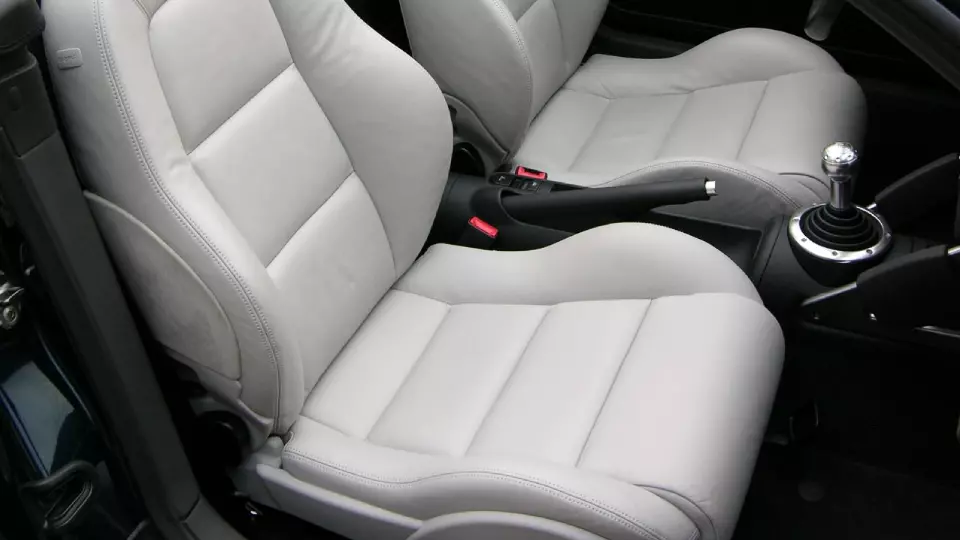How To Soften Leather Car Seats Safely
Leather is unrivaled in providing a luxurious feel to car interiors and seat covers. Regardless of the make or model of the vehicle, driving with plush leather upholstery enhances the overall driving experience.
This can be attributed to the opulent appearance and supple texture of the leather material. However, with time and use, leather car seats can lose their natural soft texture and become hard.
The presence of dust and perspiration in aged leather car seats can cause discomfort and harbor mold. Similarly, new leather car seats necessitate a breaking-in period to attain a supple texture.
Leather car seats can be easily softened by using an off-the-shelf cleaner or a white vinegar solution. We’ll teach you all this and more in this guide – let’s get started!
1. Clean Your Leather Car Seats
The first step to softening your leather car seats is to clean them. One of the top reasons why old leather car seats harden is because dust, grime, and sweat get trapped in the material.
If you don’t regularly care for your leather car seats, they may become brittle and begin cracking. You can clean your leather car seats with a dedicated leather car seat cleaner or use a homemade white vinegar and water solution.
Both of these methods are highly effective in cleaning leather safely. Be sure to dust all loose dust from the seat beforehand so the cleaning agents can remove tough dirt from the leather.
Using an Off-the-Shelf Leather Car Seat Cleaner
You can use an off-the-shelf leather car seat cleaner to wipe away the grime and embedded dust from the leather seats. Dedicated leather cleaning products always contain safe-to-use ingredients, so you only need to follow the product label instructions to clean leather car seats effectively.
Simply apply the product onto a clean cloth and wipe all dirt and grime from the seat away. Make sure that you’re using a microfiber cloth.
Using a White Vinegar & Water Solution
If you don’t want to invest in a dedicated leather car seat cleaner, you can create an effective leather cleaning solution with ingredients found at home. Mix one part of white vinegar with one part of water and use a microfiber cloth to wipe away all the grime and dust from the leather car seat.
2. Dry Your Leather Car Seats
The next step in the process is to dry your leather car seats by using a clean and soft microfiber cloth. Start by removing any excess product or water from the leather.
Water can be damaging to leather, so it is best to wipe any leftover vinegar and water with a cloth. You can use more than one cloth to dry the leather car seats if the surface area is too large or too wet.
You may also want to open your window and doors to speed up the drying process. Just ensure that you don’t expose leather to direct sunlight.
3. Condition Your Leather Car Seats
A crucial measure for achieving supple leather car seats involves the application of a suitable leather conditioner. Leather conditioners are formulated to safeguard and soften the material.
To initiate the conditioning process, pour the product onto a soft microfiber cloth and proceed to cleanse the entire leather surface. We’ve had great success using the Weiman Leather Cleaner and Conditioner, but you’re able to get similar results with other conditioners (read our full review of this leather conditioner here).
Despite the effectiveness of a dedicated leather conditioner, it is advisable to exercise care by conducting a patch test in an inconspicuous area of your leather seats prior to a complete application.
This preventive measure helps to avert potential discoloration should the conditioning product prove incompatible with the leather.
4. Apply a Leather Protector to Your Car Seats
Although some leather conditioners promote stain and water resistance it’s best to use a leather protectant for the best results. A leather protectant builds a protective barrier on the leather car seats’ surface and prevents damage from harsh sun rays, water, and accidental spills.
Best Practices for Softening Leather Car Seats
It’s vital that you soften your leather car seats using suitable techniques and suitable products to avoid permanent damage. While a leather conditioner is a great way to soften leather car seats, there are additional techniques to maintain the seats in optimal condition.
Below, you’ll find some best practices that you should consider. These techniques complement the use of a leather conditioner and can help to prolong the life of the leather car seats.
Keep Your Leather Car Seats Cool
Leather car seats can get irreversibly damaged from heat exposure. Heat can cause the leather to become hard, and excessive exposure can cause it to lose its protective layer.
If you want to keep your leather car seats soft and supple, it is best to keep your car well-ventilated and the internal temperature of the vehicle cool. Moreover, during hot weather conditions, the sun’s rays can cause the leather seats to crack and fade.
Therefore, it’s advisable to park the car in a shaded area or use sunshades to protect the seats and keep them supple for a long time.
Store Heavy Items In Your Trunk Instead
If you are transporting heavier or larger items it’s best to store them in your trunk, instead of on your leather car seats. Placing heavy objects on leather seats can cause them to stretch out the leather over time.
Avoid Contact with Soiled Clothes Or Objects
When entering your car while drenched in rain or wearing soiled clothes, there is a significant likelihood that moisture or impurities will transfer onto the leather car seats.
The accumulation of moisture and dirt particles can lead to the hardening of the leather material. Therefore, we recommended that you take precautions to keep the leather seats free of contaminants to prevent the loss of softness and suppleness of the leather material.

About Gerrit
Co-Founder, Researcher & Writer At Leatherskill
I’m a leather enthusiast who spends most of his free time crafting, researching, and writing about the many facets of this versatile material. Thanks for reading!

